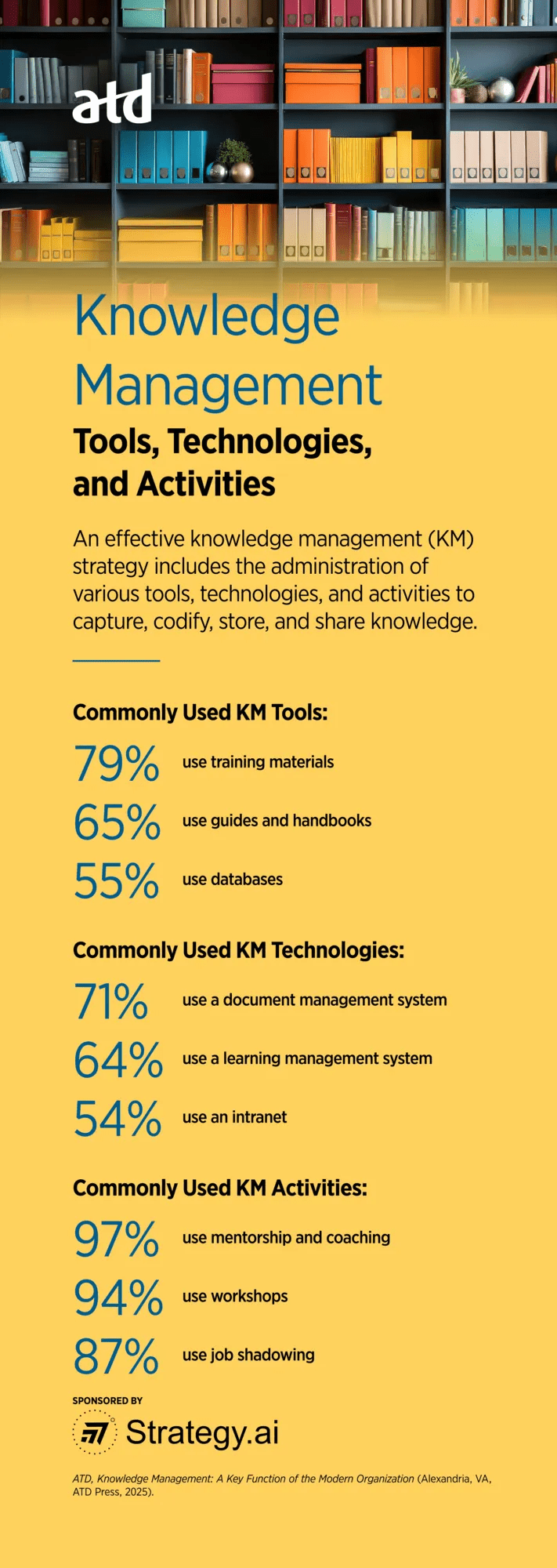ATD Blog
Methods and Tools for Knowledge Management
ATD Research explores the most commonly used knowledge management tools.
Mon May 12 2025

In today’s economy, knowledge takes center stage. Organizations are tasked with managing information and knowledge assets in this service-based economy as opposed to physical or material assets in the foregone industrial-based economy. Knowledge management—developed in response to this shift—is one of the 23 capabilities in the Talent Development Capability Model™, which delineates what talent development (TD) professionals need to know and do to be successful.
In March 2025, ATD Research published Knowledge Management: A Key Function of the Modern Organization, sponsored by Strategy.ai. In this research report, 313 TD professionals answered questions about the different methods and tools their organizations use to practice knowledge management, how they plan for and mitigate knowledge loss when employees leave, and their knowledge sharing culture with a multigenerational workforce.
A comprehensive knowledge management strategy is enabled by a variety of tools, technologies, and activities to capture, codify, store, and share knowledge.
Our study found that the most commonly used knowledge management tools include training materials, guides and handbooks, and databases. Training materials are widely used by 79 percent of organizations. Training materials are commonly developed by capturing the knowledge of subject matter experts (SMEs), so these assets play a key role in the codification and formalization of knowledge.
Today, technology is vital to knowledge management. It can enable any part of an organization’s knowledge management process or strategy. In our study, the most commonly reported technologies used included document management systems (DMS), learning management systems (LMS), and intranets. Seventy-one percent of organizations cited using a DMS. According to Atlassian, a DMS enables efficient document organization, search, and retrieval. This can foster knowledge sharing and collaboration not only within teams but across teams or departments. A DMS also helps mitigate risk by allowing organizations to implement version control and tracking as well as access control and security measures.
There are many activities organizations can use in person or virtually to promote knowledge sharing and create an environment for social connection and bonding. Our study found that most organizations use a variety of activities such as mentorship and coaching, workshops, job shadowing, communities of practice, and lunch & learns. Mentorship and coaching were most common, with 97 percent of organizations citing their use. According to Forbes, skill development is one of the greatest benefits of mentorship programs because mentors are engaged in the knowledge sharing of their experiences and expertise with mentees. Mentorship also promotes a culture of community and collaboration within an organization, which can be important to establishing a knowledge sharing culture.
To learn more about the different methods and tools organizations are using to practice knowledge management, check out ATD’s latest research report, Knowledge Management: A Key Function of the Modern Organization, sponsored by Strategy.ai.

